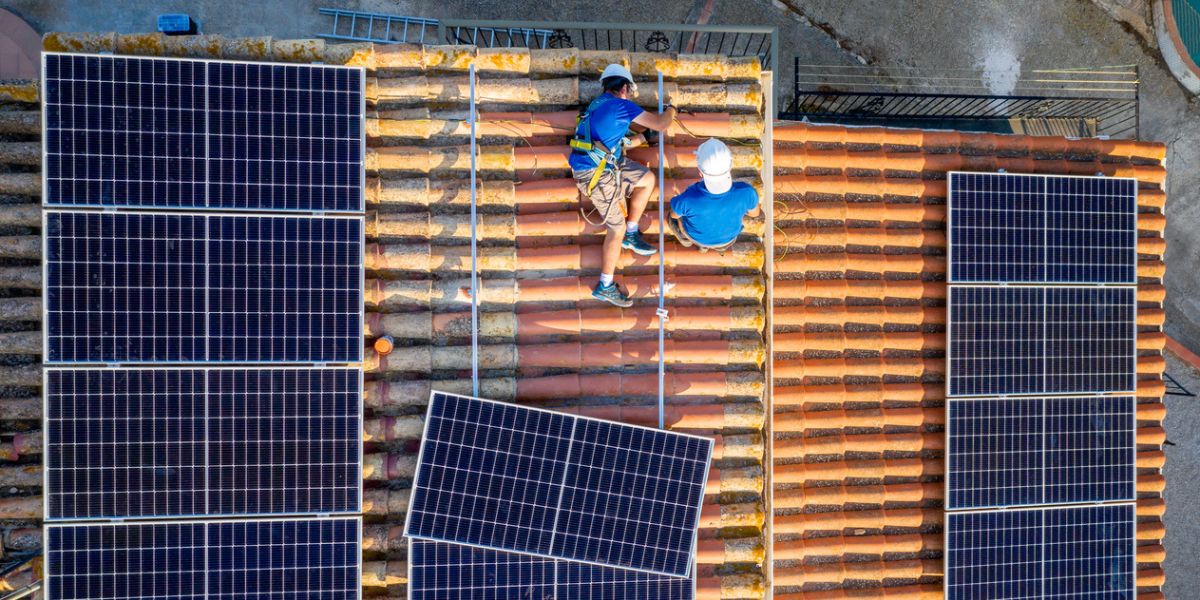The draft regulations are now open for public objections, comments, and suggestions until 30 June, to be submitted to the KSERC Secretary.
Published Jun 05, 2025 | 8:00 AM ⚊ Updated Jun 05, 2025 | 8:00 AM

Rooftop solar panels. (iStock)
Synopsis: Kerala is planning a decentralised Peer-to-Peer (P2P) energy trading framework — a system where prosumers can sell surplus power through an authorised online platform.
Imagine selling the extra power your rooftop solar panels generate directly to your neighbour, or exporting surplus charge from your electric vehicle (EV) back to the grid for a fair price. Kerala is gearing up to turn this into reality.
In a landmark move to modernise its renewable energy ecosystem, the Kerala State Electricity Regulatory Commission (KSERC) has published a draft of the Kerala State Electricity Regulatory Commission (Renewable Energy and Related Matters) Regulations, 2025, introducing a raft of forward-looking provisions that promise to democratise and decentralise energy trade in the state.
Released on 30 May, the draft regulations invite public feedback within a month, ahead of a planned public hearing.
At the heart of the draft is a decentralised Peer-to-Peer (P2P) energy trading framework — a system where prosumers (consumers who also produce electricity, typically from rooftop solar) can sell surplus power through an authorised online platform.
The transactions would use blockchain or other approved technologies, moving beyond the current option of banking excess power with the Kerala State Electricity Board (KSEB).
“The P2P platform would give every small-scale renewable energy generator a stake in the power market,” a senior KSERC official told South First. “It’s open access with a democratic twist.”
The distribution licensee (KSEB) will serve as the nodal agency for onboarding participants, regulating the transactions, and ensuring grid stability. Service providers must also create awareness and provide training for participants on using the platform.
Another innovative feature is the introduction of Virtual Power Plants (VPPs) — systems where various distributed renewable energy resources such as rooftop solar, battery storage, electric vehicles, and demand response systems are aggregated via a central operator to participate in the power market.
In addition, Virtual Net Metering (VNM) and Group Net Metering (GNM) mechanisms will make renewable energy projects accessible to flats, residential associations, and communities.
Under these models, power generated from a shared installation can be fed into the grid and the benefit distributed among participants based on individual contributions.
Recognising that daytime solar generation often exceeds consumption, the draft places fresh emphasis on energy storage solutions — from Battery Energy Storage Systems (BESS) to Pumped Storage Projects (PSP) — to store surplus power and release it during peak demand hours.
Taking e-mobility integration a step ahead, the draft introduces provisions for Vehicle-to-Grid (V2G) technology. EV owners will soon have the right to export stored power from their vehicle batteries to the grid through authorised charging stations, especially during peak demand periods.
To encourage participation, a special Time-of-Use (ToU) tariff will be introduced, offering incentives for energy exports during high-demand slots. Dynamic pricing mechanisms will also be explored, compensating EV owners based on real-time grid requirements.
The draft regulations are now open for public objections, comments, and suggestions until 30 June, to be submitted to the KSERC Secretary. A public hearing date will be announced later.
Industry experts believe the new regulations could fast-track Kerala’s energy transition goals.
“This draft is a transformative step in creating a decentralised, participatory, and future-ready power system,” said a KSEB official. “From empowering rooftop solar owners to integrating EVs as grid assets, these measures can redefine how we produce, share, and consume electricity in Kerala,” added the officer.
Kerala’s power generation landscape remains heavily reliant on hydel sources. The state’s total installed power capacity stood at 3,818.82 megawatt (MW), with hydroelectric power contributing the lion’s share at 2,183.57 MW (57.2%).
Solar energy continued to make steady gains, accounting for 1,027.4 MW (26.9%), while thermal power contributed 536.54 MW (14.0%).
As of April 2025, in the solar sector, KSEB had 2,18,878 domestic consumers, 705 industrial consumers, 15,081 commercial consumers and others.
Wind energy remained a minor player in the state’s energy mix, with an installed capacity of 71.3 MW (1.9%).
The figures reflect Kerala’s growing emphasis on renewable sources, particularly solar, even as hydel projects remain the backbone of the state’s electricity generation.
(Edited by Muhammed Fazil.)
